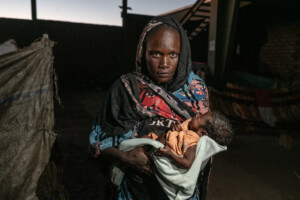‘Three million children in Sudan suffer from malnutrition’: UN
One million children in Sudan under the age of five suffer from acute malnutrition. Some 550,000 among them are at risk of dying. Another two million are stunted owing to chronic malnutrition, OCHA Sudan reports in its latest weekly bulletin.
One million children in Sudan under the age of five suffer from acute malnutrition. Some 550,000 among them are severely malnourished and at risk of dying. Another two million are stunted owing to chronic malnutrition.
Of Sudan’s 184 localities, 53 have severe acute malnutrition (SAM) rates that are classified as 'very critical' (above three percent), the UN Office for the Coordination of Humanitarian Affairs (OCHA) in Sudan reports in its latest weekly bulletin.
The highest SAM rates measured are above 20 percent, and are found in three localities in South Darfur and Red Sea states. Most of the children with SAM are found in North Darfur, El Gezira, South Darfur, Khartoum and El Gedaref. These five states carry 51 percent of the national SAM burden.
A S3M (Simple Spatial Survey Methodology used to collect data on child malnutrition) survey conducted by Unicef in 2013 revealed that 128 of the 184 localities in Sudan have a stunting rate classified as ‘high’ (above 30 percent). Moreover, there are pockets of very high stunting rates, found mostly in the eastern states of Red Sea, Kassala and El Gedaref, with the highest being El Gedaref at 73 percent.
This results in an average global acute malnutrition (GAM) rate of 16.3 percent, which is above the 15 percent threshold that constitutes a critical emergency.
In several localities across the country, however, the GAM rate is alarmingly higher. In Red Sea state, Toker locality has a GAM rate as high as 46.7 percent, and in Agig locality it constitutes 37.4 percent.
Among the Darfur states, the poorest nutrition levels were observed in North Darfur, where El Sereif, Alliet, Dar El Salam, and Kalamindo localities have GAM rates above 25 percent.
Some progress
Results of the recent Multiple Indicator Cluster Survey (MICS 2014), however, highlight some of the progress being made in child health across Sudan. These include a 21 percent reduction in child mortality rates over the last decade.
Despite these gains, however, child mortality remains very high and the situation of children remains critical, OCHA reports. According to Unicef, the key drivers of this poor situation are the high incidence of communicable diseases amongst children, particularly diarrhoea, measles, pneumonia and malaria, and lack of access to basic services such as quality health care and safe water and sanitation facilities. Ongoing conflict, displacement and food insecurity continue to fuel and exacerbate the situation.
Furthermore, with the start of the lean season all feeding centres for severely malnourished children are experiencing an increasing number of children identified for treatment, leading to overcrowding in hospitals.
In Ed Daein, capital of East Darfur, the international Tearfund organisation recently reported a high number of malnourished children in its stabilisation centre, forcing each bed to be shared by two children.
Shortage of nutrition supplements
OCHA further reports that the World Food Programme (WFP) nutrition interventions are constrained by a lack of funding, as well as difficulties in importing nutrition supplements (super cereals) because of genetically modified organism (GMO) regulations in Sudan.
The nearly depleted stocks of super cereals will not be enough to sustain treatment programmes for more than 150,000 acutely malnourished children and pregnant or lactating women in need.
The WFP hopes to mitigate the impact of these shortfalls by locally procuring some quantities of super cereals, the OCHA bulletin reads. The UN organisation is also working closely with the Sudanese Bio-Safety Council to address the government’s zero tolerance for GMO in specialised food to resolve the issue.











 and then
and then